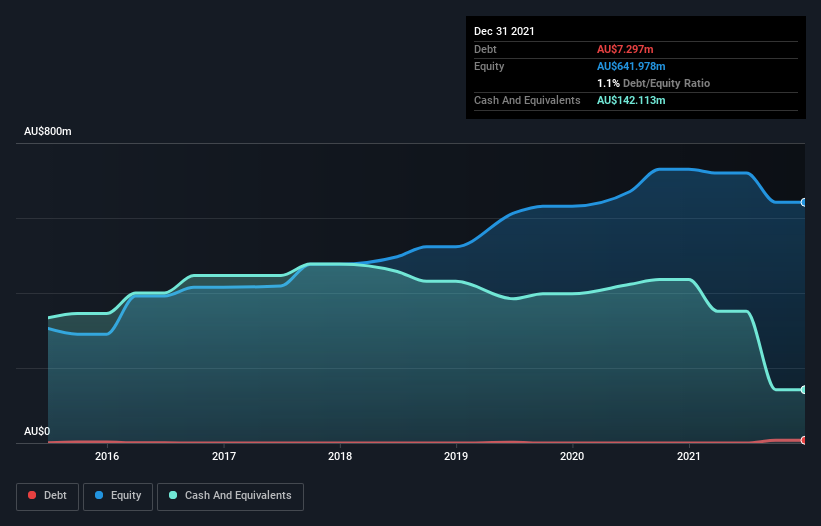
David Iben put it well when he said, 'Volatility is not a risk we care about. What we care about is avoiding the permanent loss of capital.' So it might be obvious that you need to consider debt, when you think about how risky any given stock is, because too much debt can sink a company. As with many other companies Mount Gibson Iron Limited (ASX:MGX) makes use of debt. But should shareholders be worried about its use of debt?
What Risk Does Debt Bring?
Debt assists a business until the business has trouble paying it off, either with new capital or with free cash flow. Part and parcel of capitalism is the process of 'creative destruction' where failed businesses are mercilessly liquidated by their bankers. However, a more common (but still painful) scenario is that it has to raise new equity capital at a low price, thus permanently diluting shareholders. Having said that, the most common situation is where a company manages its debt reasonably well - and to its own advantage. When we examine debt levels, we first consider both cash and debt levels, together.
Check out our latest analysis for Mount Gibson Iron
How Much Debt Does Mount Gibson Iron Carry?
The image below, which you can click on for greater detail, shows that at December 2021 Mount Gibson Iron had debt of AU$7.30m, up from none in one year. But it also has AU$142.1m in cash to offset that, meaning it has AU$134.8m net cash.

A Look At Mount Gibson Iron's Liabilities
The latest balance sheet data shows that Mount Gibson Iron had liabilities of AU$94.0m due within a year, and liabilities of AU$50.9m falling due after that. Offsetting this, it had AU$142.1m in cash and AU$19.0m in receivables that were due within 12 months. So it can boast AU$16.3m more liquid assets than total liabilities.
This short term liquidity is a sign that Mount Gibson Iron could probably pay off its debt with ease, as its balance sheet is far from stretched. Succinctly put, Mount Gibson Iron boasts net cash, so it's fair to say it does not have a heavy debt load! There's no doubt that we learn most about debt from the balance sheet. But it is future earnings, more than anything, that will determine Mount Gibson Iron's ability to maintain a healthy balance sheet going forward. So if you want to see what the professionals think, you might find this free report on analyst profit forecasts to be interesting.
In the last year Mount Gibson Iron had a loss before interest and tax, and actually shrunk its revenue by 78%, to AU$98m. That makes us nervous, to say the least.
So How Risky Is Mount Gibson Iron?
Statistically speaking companies that lose money are riskier than those that make money. And we do note that Mount Gibson Iron had an earnings before interest and tax (EBIT) loss, over the last year. Indeed, in that time it burnt through AU$270m of cash and made a loss of AU$76m. Given it only has net cash of AU$134.8m, the company may need to raise more capital if it doesn't reach break-even soon. Even though its balance sheet seems sufficiently liquid, debt always makes us a little nervous if a company doesn't produce free cash flow regularly. When analysing debt levels, the balance sheet is the obvious place to start. But ultimately, every company can contain risks that exist outside of the balance sheet. For example, we've discovered 3 warning signs for Mount Gibson Iron (2 shouldn't be ignored!) that you should be aware of before investing here.
Of course, if you're the type of investor who prefers buying stocks without the burden of debt, then don't hesitate to discover our exclusive list of net cash growth stocks, today.
If you're looking to trade Mount Gibson Iron, open an account with the lowest-cost platform trusted by professionals, Interactive Brokers.
With clients in over 200 countries and territories, and access to 160 markets, IBKR lets you trade stocks, options, futures, forex, bonds and funds from a single integrated account.
Enjoy no hidden fees, no account minimums, and FX conversion rates as low as 0.03%, far better than what most brokers offer.
Sponsored ContentNew: Manage All Your Stock Portfolios in One Place
We've created the ultimate portfolio companion for stock investors, and it's free.
• Connect an unlimited number of Portfolios and see your total in one currency
• Be alerted to new Warning Signs or Risks via email or mobile
• Track the Fair Value of your stocks
Have feedback on this article? Concerned about the content? Get in touch with us directly. Alternatively, email editorial-team (at) simplywallst.com.
This article by Simply Wall St is general in nature. We provide commentary based on historical data and analyst forecasts only using an unbiased methodology and our articles are not intended to be financial advice. It does not constitute a recommendation to buy or sell any stock, and does not take account of your objectives, or your financial situation. We aim to bring you long-term focused analysis driven by fundamental data. Note that our analysis may not factor in the latest price-sensitive company announcements or qualitative material. Simply Wall St has no position in any stocks mentioned.
About ASX:MGX
Mount Gibson Iron
Engages in the mining, crushing, processing, shipment, sale, and export of hematite iron ore in Australia and China.
Flawless balance sheet and slightly overvalued.


